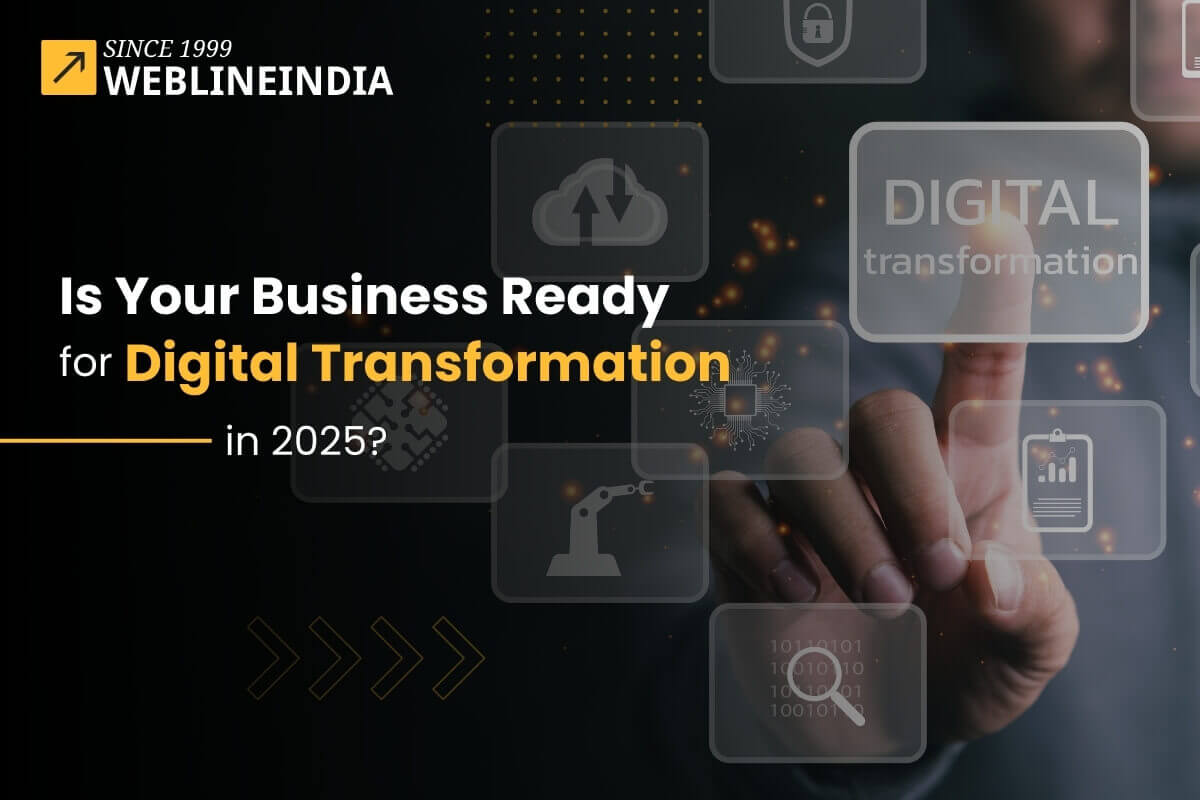Listen to the podcast :
The relentless march of technology continues to reshape the global business environment, demanding adaptability and innovation. As we approach 2025, digital transformation is no longer a mere option but an imperative for survival and success. Organizations across all sectors must embrace new technologies and innovative strategies to thrive in this evolving digital transformation in 2025.
A report by Statista quotes that in 2024, spending on digital transformation (DX) is projected to reach US $2.5 trillion. By 2027, global digital transformation spending is forecast to reach US $3.9 trillion taking the market by storm.
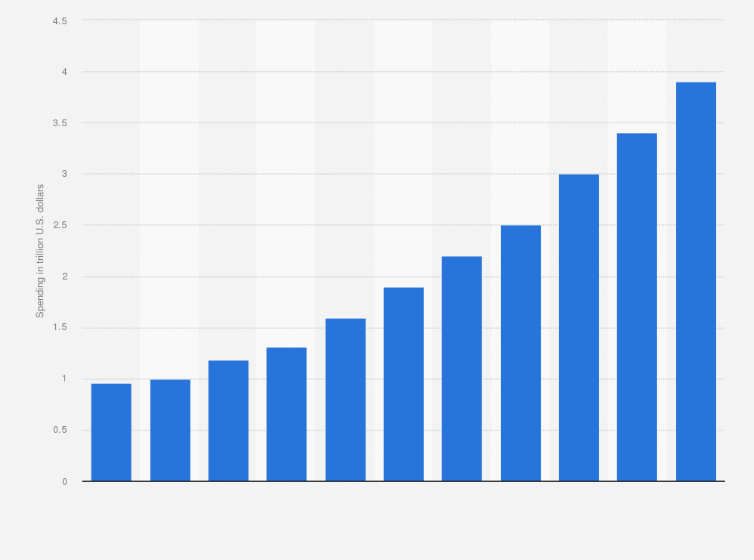
Digital transformation will be mandatory in 2025 due to the rapid advancements in technology, increased reliance on data, and shifting consumer expectations. Businesses must embrace digital tools and strategies to stay competitive, enhance operational efficiency, and deliver personalized experiences. Companies that fail to adapt may struggle to survive in an increasingly digital and interconnected world.
This blog post explores the key trends and technologies that will redefine businesses in 2025 and offers a comprehensive digital transformation guide for navigating these changes.
Is Your Business Ready to Tackle Digital Transformation Challenges in 2025?
The Convergence of Emerging Technologies
2025 will witness the convergence of several transformative technologies, creating a synergistic impact on businesses. Artificial intelligence (AI), the Internet of Things (IoT), and blockchain will intertwine, unlocking unprecedented capabilities.
AI will also analyze the massive data streams generated by IoT devices, enabling real-time decision-making and process optimization. Blockchain will ensure secure and transparent data management across complex networks, fostering trust and efficiency.
This convergence will revolutionize industries, bringing forth innovations such as:
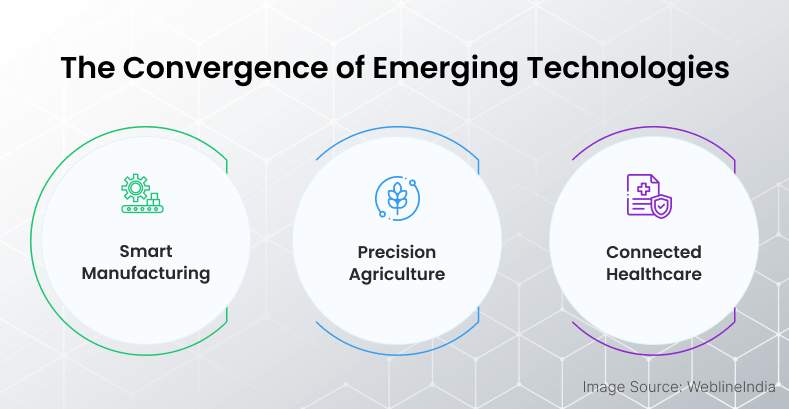
Smart Manufacturing
AI-powered robots will collaborate seamlessly with human workers on the factory floor, optimizing production lines, predicting equipment failures through real-time data analysis, and minimizing downtime. This synergy will lead to increased efficiency and productivity.
Precision Agriculture
IoT sensors will monitor crop health and soil conditions, enabling farmers to optimize irrigation and fertilization strategies. This data-driven approach will lead to increased yields, reduced resource consumption, and minimized environmental impact.
Connected Healthcare
Wearable devices will continuously monitor patient vitals, transmitting real-time data to healthcare providers. This allows for proactive interventions, personalized treatment plans, and improved healthcare outcomes. Furthermore, AI algorithms can analyze this data to identify potential health risks and suggest preventative measures.
Hyperautomation and the Rise of Intelligent Automation
Organizations are expected to increasingly implement hyperautomation, integrating a variety of technologies such as robotic process automation (RPA), artificial intelligence (AI), and machine learning (ML) to streamline complex business processes. This approach goes beyond the capabilities of rule-based automation, making it possible to handle tasks that involve unstructured data and subjective decision-making.
Precedence Research reports that the global intelligent process automation market size is expected to be valued at US $17.34 billion in 2024 and is anticipated to reach around US $67.73 billion by 2034, expanding at a CAGR of 14.6% over the forecast period from 2024 to 2034.
Intelligent automation will free employees from monotonous and repetitive duties, allowing them to concentrate on higher-level activities, such as strategic planning, creative problem-solving, and tasks that demand human-specific abilities like empathy and critical thinking. This transformation will alter job responsibilities and drive the need for reskilling and upskilling programs to ensure the workforce is equipped to work effectively alongside intelligent automation systems.
Artificial Intelligence and Digital Transformation in 2025
By 2025 and beyond, AI, particularly generative AI (gen AI), will be central to how businesses operate and create value, presenting vast growth opportunities. However, companies must focus on solving specific business challenges rather than chasing the latest technology trends.
McKinsey’s Eric Lamarre emphasizes that digital and AI transformations must start with a clear understanding of the business problem at hand. As the tech landscape evolves, businesses that succeed will be those who can align AI innovations with their objectives, ensuring scalability and meaningful impact. Lamarre also points out that while gen AI is gaining traction, it can sometimes seem like a solution in search of a problem. To build long-term value with gen AI, businesses will need a well-defined strategy, skilled in-house talent, and an adaptable operational model.
In 2025, AI and digital transformation will reshape business operations by enhancing productivity, efficiency, decision-making, and customer experiences. Essential strategies involve leveraging AI, optimizing data use, adopting cloud technologies, upskilling employees, and promoting innovation, among others. Though challenges such as cybersecurity risks and skill shortages remain, they can be addressed with the right strategies.
Looking to Hire the Right Expert Dev Team to Drive Growth Through Digital Transformation?
The Rise of the Metaverse and Web 3.0
Starting in 2025, the metaverse—a continuous, immersive digital environment—will begin to have a substantial effect on businesses. Market.US mentions that the Web 3.0 market was valued at US $3.2 billion in 2021, with North America holding the largest market share at approximately 34%. The market capitalization of Web 3.0 is estimated to have reached US $27.5 billion, reflecting significant growth. In the first quarter of 2022 alone, companies in the Web 3.0 sector raised over US $1.8 billion, further highlighting the increasing investment and interest in this emerging digital ecosystem.
Companies will look for creative ways to interact with customers and employees within this virtual space, developing digital storefronts, collaborative work environments, and interactive training experiences. For example, new employees could be onboarded in a virtual version of the office, enabling them to explore the workspace and meet colleagues before their official start date. At the same time, Web 3.0, with its decentralized framework and focus on user control of data, will further transform online business practices.
Decentralized applications (dApps) and blockchain-based systems will enable secure, transparent transactions, building trust and giving users more control. This shift will require businesses to rethink their models and strategies to fully exploit the potential of the metaverse and Web 3.0, including:
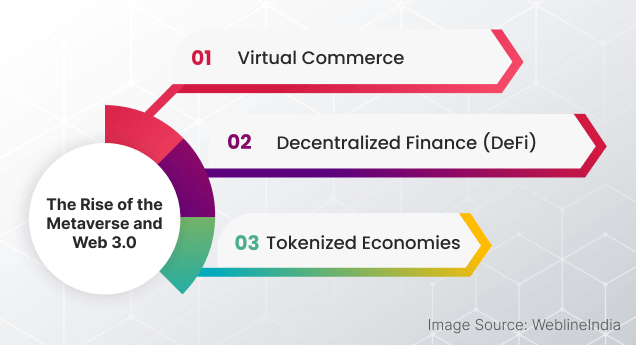
Virtual Commerce
Brands will establish virtual storefronts in the metaverse, offering immersive shopping experiences and personalized product recommendations. Customers can virtually try on clothes, explore products in 3D, and interact with sales representatives in real time, all from the comfort of their homes.
Decentralized Finance (DeFi)
Web 3.0 will enable the creation of decentralized financial systems, offering users greater control over their assets and financial data. This will lead to more transparent and secure financial transactions, reducing reliance on traditional intermediaries.
Tokenized Economies
Organizations will leverage blockchain technology to create tokenized economies, rewarding customer loyalty and incentivizing engagement. Customers can earn tokens for various actions, such as making purchases, referring friends, or providing feedback, and these tokens can be redeemed for rewards or exclusive access to products and services.
The Pervasiveness of Edge Computing
Edge computing, which brings computation and data storage closer to the source of data generation, will become increasingly critical in 2025. This will empower organizations to process data in real time, reducing latency and enabling agile responses to dynamic situations. Industries with mission-critical applications, such as manufacturing and healthcare, will particularly benefit from edge computing.
See it like a factory floor where AI-powered robots analyze data from sensors in real-time to optimize production processes and predict equipment failures. Similarly, in healthcare, edge computing will enable real-time analysis of patient data, facilitating timely interventions and improving healthcare outcomes. This technology is crucial for applications requiring immediate response, such as autonomous vehicles and remote surgery.
Cybersecurity: A Paramount Concern in the Age of Digital Transformation
As businesses become increasingly reliant on digital technologies, cybersecurity will become even more paramount in 2025. Organizations will need to adopt a proactive and multi-layered approach to cybersecurity, incorporating AI-powered threat detection, zero-trust security frameworks, and robust data encryption.
In addition, ensuring a culture of cybersecurity awareness among employees will be crucial in mitigating human error, a leading cause of security breaches. Regular training and simulated phishing attacks can help employees recognize and avoid potential threats.
A Guide to Digital Transformation in 2025
Navigating the complexities of digital transformation in 2025 requires a strategic roadmap and expert digital transformation services to ensure smooth adoption and implementation.
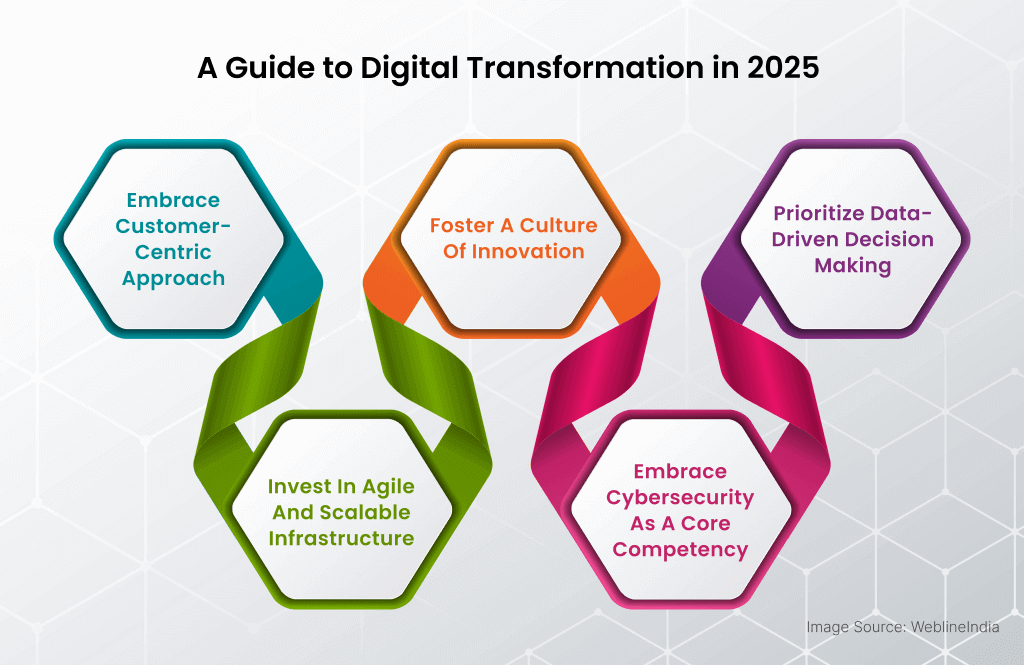
- Embrace a Customer-Centric Approach: Place the customer at the heart of your digital transformation strategy. Understand their evolving needs and preferences, and tailor your products, services, and digital experiences accordingly. Utilize data analytics to gain insights into customer behavior and personalize their interactions with your brand.
- Foster a Culture of Innovation: Cultivate a culture that fosters digital transformation success by encouraging experimentation, continuous learning, and the adoption of new technologies. Empower employees to identify opportunities for digital transformation and contribute to its progress. This can be achieved through hackathons, innovation challenges, and providing access to learning resources and training programs.
- Prioritize Data-Driven Decision Making: Data is the lifeblood of digital transformation. Implement robust data analytics platforms and leverage AI and ML to extract actionable insights from your data. This will enable you to make informed decisions, optimize operations, and identify new business opportunities.
- Invest in Agile and Scalable Infrastructure: Ensure your IT infrastructure is agile and scalable to accommodate the demands of emerging technologies and evolving business needs. Cloud computing and microservices architectures offer the flexibility and scalability required for successful digital transformation.
- Embrace Cybersecurity as a Core Competency: Integrate cybersecurity into every facet of your digital transformation strategy. Implement robust security measures and foster a culture of cybersecurity awareness throughout your organization.
Ready to welcome digital transformation in 2025 or happy to be in the past?
It is high time that you partner with a renowned digital transformation agency in 2025. It is not merely about adopting new technologies but it’s about fundamentally reimagining how your business operates.
Organizations that successfully navigate this transformation will emerge as leaders in their respective industries, while those that resist change risk obsolescence. You can position yourself for success in the dynamic digital era of the future by embracing the trends outlined in this guide to digital transformation in 2025.
Social Hashtags
#DigitalTransformation #AITransformation #BusinessGrowth #DigitalStrategy #BusinessSuccess #DigitalTransformationin2025
Ready to Transform Your Business with Expert Digital Solutions in 2025?
Testimonials: Hear It Straight From Our Customers
Our development processes delivers dynamic solutions to tackle business challenges, optimize costs, and drive digital transformation. Expert-backed solutions enhance client retention and online presence, with proven success stories highlighting real-world problem-solving through innovative applications. Our esteemed clients just experienced it.
